You’ll create authentic Thai khanom gluay by combining mashed ripe bananas with rice flour, coconut milk, and palm sugar until smooth. Place the mixture in banana leaf packets or traditional molds, then steam for 20-25 minutes until firm. Let it cool slightly before unmolding and cutting into diamond shapes. Serve this aromatic dessert warm, garnished with fresh coconut shavings. Master this beloved Thai treat’s techniques to honor its rich cultural heritage.
Key Takeaways
- Combine mashed bananas, rice flour, coconut milk, palm sugar, and salt to create a smooth, well-mixed batter.
- Pour the mixture into greased traditional Thai steaming molds or wrap portions in banana leaves.
- Steam for 20-25 minutes with consistent heat, keeping water at a gentle simmer throughout cooking.
- Test doneness with a bamboo skewer and allow cakes to cool in molds for 10 minutes.
- Slice into diamond shapes and serve warm, garnished with fresh coconut shavings and pandan leaves.
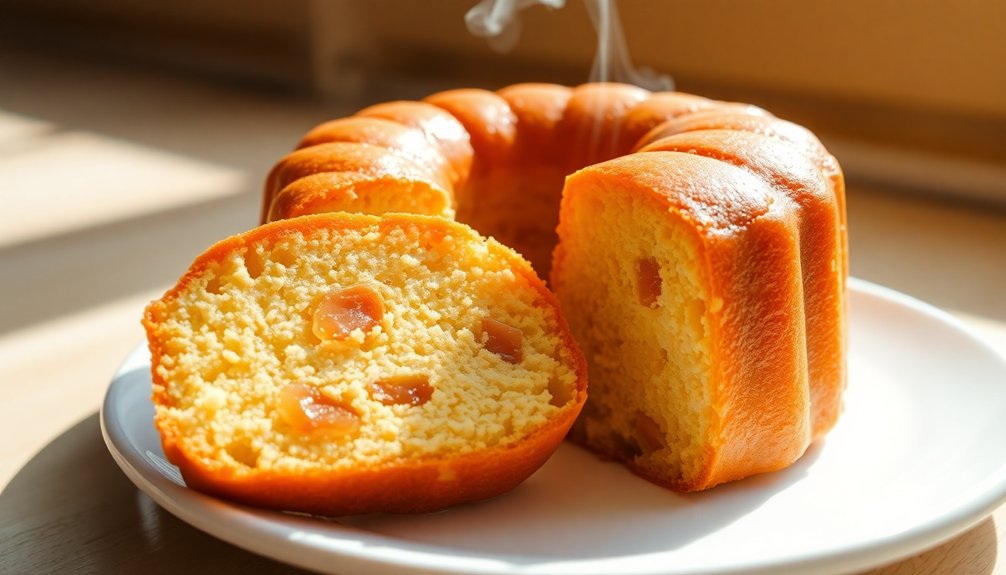
History
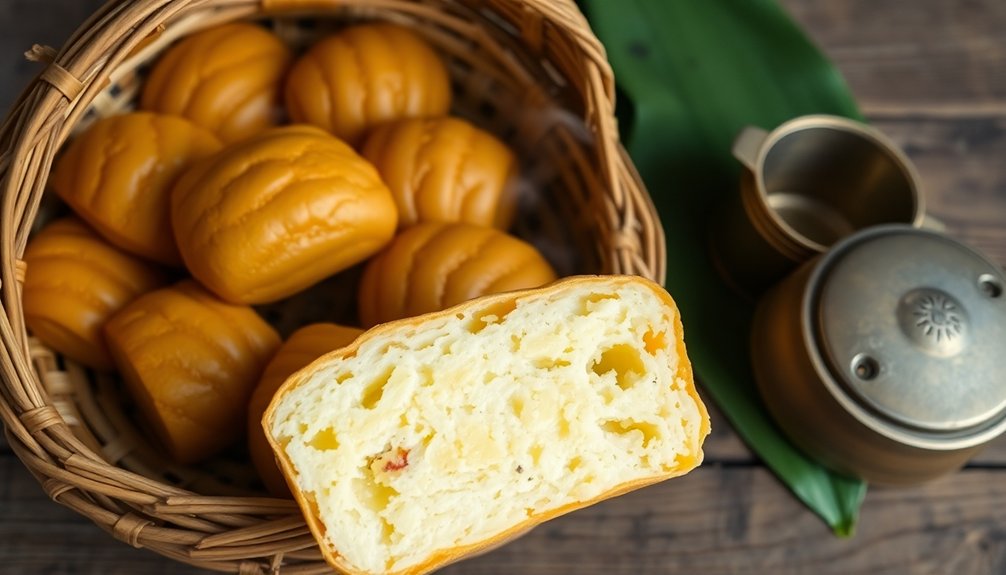
The origins of Khanom Gluay can be traced back through generations of Thai home cooking, where families would transform their surplus bananas into these delicate steamed dumplings.
Like many traditional Thai desserts, Khanom Gluay showcases the resourcefulness of rural households and their deep connection to local ingredients.
You’ll find this beloved treat has maintained its cultural significance through the years, particularly in central Thailand.
- Originally made during banana harvest seasons to prevent waste
- Gained popularity in Bangkok’s markets during the 1960s
- Traditionally served during merit-making ceremonies at temples
- Became a staple in Thai dessert shops nationwide by the 1980s
Today, you’ll find modern variations of this classic dessert, but the core technique of steaming banana-filled rice dough remains unchanged, preserving its authentic charm.
Recipe
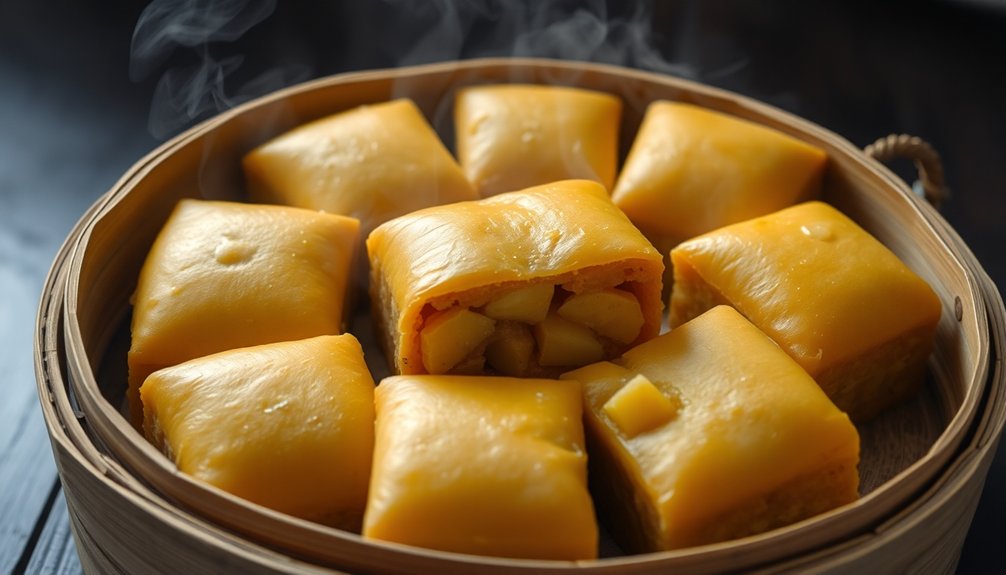
Ingredients:
- 6-8 ripe bananas, mashed
- 2 cups rice flour
- 1 cup coconut milk
- 3/4 cup palm sugar
- 1/2 teaspoon salt
- 1 cup grated coconut
- Banana leaves for wrapping
Instructions:
- Mix mashed bananas, rice flour, coconut milk, palm sugar, and salt in a large bowl until well combined.
- Clean banana leaves and cut into 6-inch squares.
- Place 2-3 tablespoons of the mixture onto each banana leaf.
- Sprinkle grated coconut on top.
- Fold banana leaves to create a packet, securing with toothpicks if needed.
- Steam the packets in a steamer for 20-25 minutes or until firm.
- Remove from steamer and let cool for 5 minutes.
- Unwrap and serve warm.
Serves 8-10 people
Cooking Steps
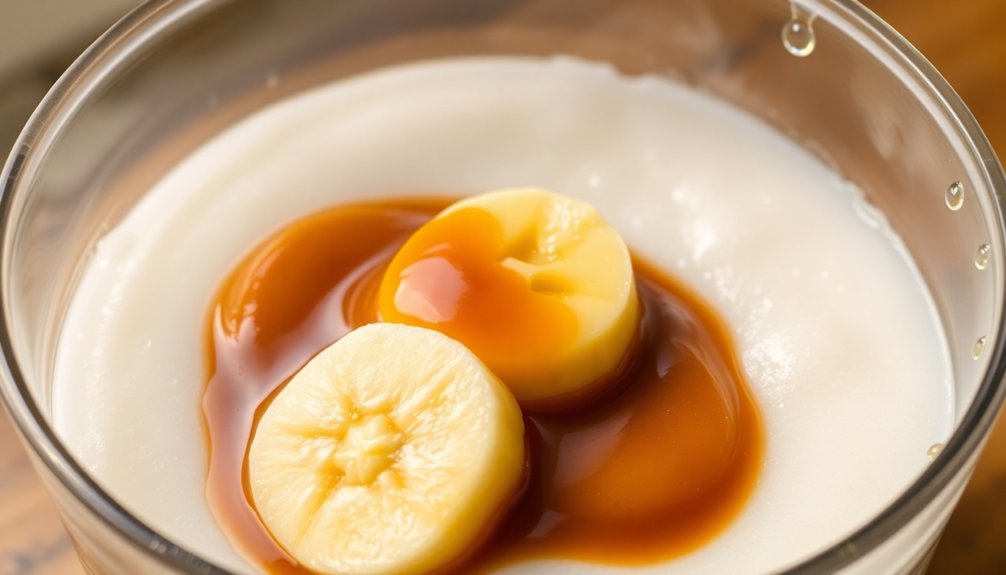
Begin by thoroughly combining your banana batter ingredients until you achieve a smooth, lump-free consistency.
Then pour the mixture into a greased traditional Thai steaming mold.
Place the filled mold into your steamer and cook at medium heat for 30 minutes, or until a skewer inserted into the center comes out clean.
Once steamed, let your khanom gluay rest for 10 minutes before unmolding, slicing into traditional diamond shapes, and serving while still warm.
Step 1. Mix Banana Batter Ingredients
Start by combining 2 cups of ripe mashed bananas with 1 cup of rice flour, 1/2 cup of tapioca starch, and 1/2 cup of coconut milk in a large mixing bowl.
For best results, use Nam Wa or Kluai Nam Wa banana varieties, as they’ll give your Khanom Gluay the authentic Thai taste and texture.
- Whisk the mixture vigorously until you achieve a smooth, lump-free batter consistency.
- Mix in 1/2 cup of palm sugar until it completely dissolves.
- Add 1/4 teaspoon of salt to balance the sweetness.
- Strain the batter through a fine-mesh sieve to remove any remaining banana fibers.
The final batter should be slightly thick but still pourable, similar to pancake batter.
If it’s too thick, gradually add more coconut milk, one tablespoon at a time.
Step 2. Pour Into Steaming Mold
Gently pour the strained banana batter into traditional Thai brass or aluminum Khanom Gluay molds, filling each cavity about 3/4 full to allow room for the batter to rise during steaming.
If you’re using vintage brass molds, first coat them lightly with cooking oil to prevent sticking. While traditional molds create the authentic flower-shaped cakes, you can substitute with small ceramic ramekins or stainless steel cupcake molds. Just make sure they’ll fit in your steamer.
Tap each filled mold gently against your work surface a few times to release any trapped air bubbles that could create holes in your finished cakes.
If you notice any spills on the mold’s edges, wipe them clean with a damp cloth before steaming to make sure a neat presentation.
Step 3. Steam for Thirty Minutes
Place the filled molds in your steamer basket, ensuring they’re positioned at least 1/2 inch apart to allow proper steam circulation.
Cover the steamer with a tight-fitting lid and steam over medium heat for exactly 30 minutes. Proper steaming techniques are essential for achieving the perfect texture.
- Don’t lift the lid during the first 20 minutes, as this disrupts the steaming process and can cause uneven cooking.
- Check the water level periodically through the side vent to maintain consistent steam.
- Listen for the gentle bubbling sound that indicates the right steaming temperature.
- Test for doneness by inserting a toothpick into the center – it should come out clean.
Timing importance can’t be overstated – under-steaming results in a gummy texture, while over-steaming makes the khanom gluay too dry and dense.
Step 4. Cool For Ten Minutes
Once your khanom gluay has finished steaming, remove the steamer from heat and let the desserts cool in their molds for exactly 10 minutes. This cooling period is essential for the proper texture development of your Thai banana cakes.
While traditional cooling techniques call for leaving the desserts in their molds, you’ll want to make sure they’re placed on a wire rack to allow proper air circulation.
If you’ve used baking alternatives like an oven with a water bath instead of a steamer, follow the same cooling process. Don’t remove the cakes too early, as they need this time to set properly and develop their characteristic soft, bouncy texture.
After exactly 10 minutes, you can proceed to unmold your khanom gluay. They should feel firm but still warm to the touch.
Step 5. Slice and Serve Warm
Now that your khanom gluay has cooled properly, carefully unmold each cake onto a serving plate.
Using a sharp knife, slice each cake diagonally into triangular pieces, about 2 inches wide. Serve while still warm for the best texture and flavor experience.
Consider these traditional serving suggestions to enhance your khanom gluay:
- Drizzle with warm coconut cream sauce for added richness
- Pair with Thai iced tea or hot jasmine tea
- Top with fresh ripe mango slices for a tropical twist
- Garnish with toasted sesame seeds for extra crunch
Remember that khanom gluay tastes best when enjoyed within a few hours of steaming.
If you need to reheat, simply steam the slices for 1-2 minutes to restore their soft, pillowy texture.
Cooking Tips

To achieve the ideal texture in khanom gluay, maintaining consistent heat throughout the steaming process is essential.
You’ll want to keep the water at a gentle simmer, not a rolling boil, to prevent the cake from becoming dense or rubbery. If you don’t have banana leaves, you can substitute parchment paper, though you’ll miss some of the traditional aroma.
When mixing the batter, don’t overmix – stop as soon as the ingredients are well combined.
For the best cooking techniques, place your steaming rack high enough above the water to prevent the cakes from getting wet. If you’re using frozen banana leaves, thaw them completely and wipe dry before use.
You can test doneness by inserting a bamboo skewer – it should come out clean.
Final Thoughts
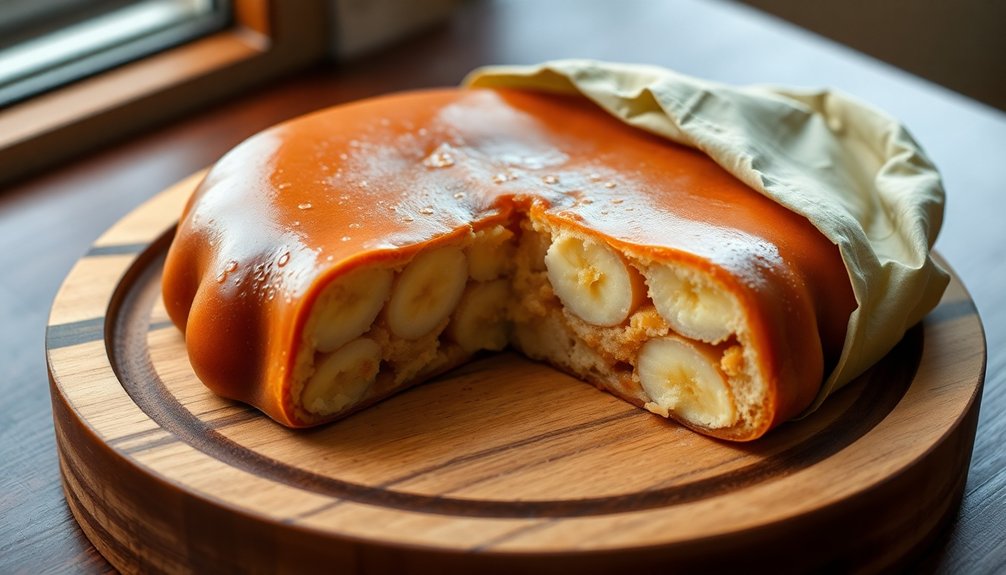
While khanom gluay might seem challenging at first, mastering this traditional Thai dessert brings immense satisfaction and connects you to generations of home cooks.
The cultural significance of this beloved banana cake extends beyond its delicious taste, as it’s often shared during festivals and family gatherings.
- Serve your khanom gluay warm with afternoon tea, following Thai tradition.
- Enhance the presentation by garnishing with fresh pandan leaves and coconut shavings.
- Pack individual portions in banana leaves for an authentic touch when sharing with friends.
- Consider pairing it with Thai iced tea for a complete traditional dessert experience.
Remember that practice makes perfect, and each time you make this steamed cake, you’ll develop a deeper appreciation for Thai culinary heritage and the art of traditional dessert-making.
Frequently Asked Questions
Can I Substitute Banana With Other Fruits in This Recipe?
While you can experiment with fruit variations like mango or jackfruit, banana’s unique texture and natural sweetness create flavor combinations that other fruits can’t quite match in this traditional steam-cooking method.
How Long Can I Store Khanom Gluay at Room Temperature?
You’ll want to eat your khanom gluay within 24 hours at room temperature for the best texture. For longer storage tips, wrap individual pieces and refrigerate – they’ll keep their shelf life for 3-4 days.
Why Did My Khanom Gluay Turn Out Dense and Rubbery?
Feeling defeated by dense desserts? Your rubbery texture likely comes from overmixing the batter or using underripe bananas. Perfect baking technique requires gentle folding and high-quality, ripe ingredients for ideal results.
Is It Possible to Make Khanom Gluay Without a Steamer?
You can try steaming alternatives like a DIY steamer using a large pot with a raised platform, but traditional baking methods won’t achieve khanom gluay’s signature soft, bouncy texture.
Can I Use Frozen Bananas Instead of Fresh Ones?
A penny saved isn’t always earned – frozen bananas will affect your texture negatively. You’ll want perfectly ripened fresh bananas since frozen ones release excess moisture during thawing.
